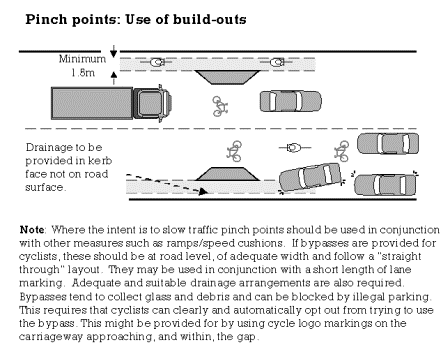
Galway Cycling Campaign -Feachtas Rothaiochta na Gaillimhe
Road Narrowings and Pinch Points
An Information Sheet
What's the issue?
Road narrowings and pinch points are a source
of concern to many cyclists [1] .
This is especially the case on roads with fast moving and/or heavy traffic.
At many locations motorists will treat cyclists as an obstacle to be overtaken
at all costs. This can result in either aggressive overtaking manoeuvres
prior to the narrowing or close proximity overtaking within the feature.
Narrowings such as footway build-outs or central islands may be applied
as part of pedestrian crossing installations. Alternatively they
may be applied as a speed-reducing feature in traffic calming schemes.
There is a strong argument that in the latter application the main speed-reducing
factor is the presence of cyclists in the traffic stream. In effect
the cyclist is being used as the traffic-calming feature, this is obviously
viewed as unacceptable by cycling advocates. Of the two features
central islands are by far the most unpopular. The problem seems
to stem from the fact that at central island locations motor traffic is
forced in on top of cycle traffic. At build-outs the cyclist has
more choice about how he/she joins the main traffic stream. 
Pedestrian crossings.
Footway build-outs may be used as part of
signalised pedestrian crossing installations. The intent of
this type of use seems to be to reduce the delay felt by motorists while
pedestrians cross [2] . However this use is questionable,
there is no advantage for pedestrians, who still have to walk the same
distance, while cyclists may feel inconvenienced and endangered by the
installation. An emphasis on reducing motorist delay is inconsistent
with a stated official desire to reduce reliance on private cars. This
type of treatment may be appropriate where persistent car parking is obscuring
the crossing, however this is a site-specific consideration.
Examples in Galway
In the city examples of cyclist-hostile traffic island installations are found on the Headford road at the Shopping centre, at Galway Crystal and on Taylors hill (Ardilaun Hotel). Particular problems have been created by build-outs/islands at some village gateway schemes at rural locations. The GCC has been raising this issue since 1998 but has yet to receive any response from Galway Corporation. On a more positive note, Galway County Council shares our concerns and is actively seeking alternative solutions for rural locations.

Design guidance
Adequate "running lane widths" are needed. Central
island installations should not be used unless there is a clear pedestrian
crossing requirement or a cycle track crossing is required. At locations
where central refuges are being used a running lane width of at least
4.5 m is needed to allow adequate overtaking space. Gaps of
intermediate width and especially in the range 3.1-3.9m should be avoided [3] . On lightly trafficked roads with
low speeds (<30mph) a gap of 3m is said to be acceptable as motorists
will tend to wait behind cyclists. However, at some sites motorists
may try to race cyclists for the gap, this behaviour is complicated by
the tendency of some motorists to significantly underestimate cycling
speeds. Accordingly, if the pinch point is being applied as
part of a "traffic calming" scheme additional speed reducing
measures such as speed ramps or cushions should also be used in advance
of the feature. If bypasses are provided they must follow a "straight
through" layout and be at the same level as the carriageway.
Carefully sited and adequate drainage is necessary as well as an increased
commitment to sweeping and maintenance.
Turning reservoirs
A turning reservoir might be considered to be a special kind of central island, in that waiting vehicles represent a transient pinch point. The Galway Cycling Campaign has not obtained/developed guidance for these locations. However it seems reasonable to assume that the same concerns regarding appropriate running lane widths would apply at these sites.
Advice for cyclists
The standard advice for cyclists who encounter road narrowings is that they should adopt the primary cycling position in the centre of the lane [4] . This helps to deter motorists from overtaking within the gap while the cyclist has more room for evasive action in the event of a following motorist trying anything dangerous. However be prudent and plan your approach well in advance, particularly on faster roads and at night. If there is only one following vehicle it may be less hassle to stop pedalling briefly and let it past. It might be possible to facilitate and reinforce cyclists' right to protect themselves such as by marking cycle logos in the centre of the lane. The Galway Cycling Campaign is also seeking an additional road sign emphasising that an overtaking ban also precludes motorists from attempting to overtake cyclists.
© Galway Cycling Campaign, February 2001
The Galway Cycling Campaign can be contacted c/o the One
World Centre, The Halls, Quay St, Galway
[1] Cyclists at Road Narrowings, DG Davies, TJ Ryley, SB Taylor and ME Halliday, TRL Report No. 241, 1997
[2] Footway buildouts at pedestrian crossings, Cambridge Cycling Campaign, September 1996
[3] Cycle Friendly Infrastructure, Guidelines for Planning and Design, Institute of Highways and Transportation, 1996
[4] Cyclecraft: Skilled cycling Techniques for Adults, John Franklin, UK Stationery Office, 1998